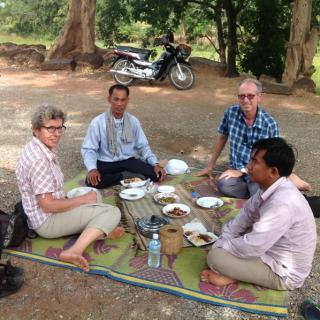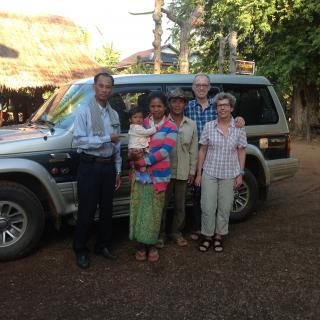


.jpg)









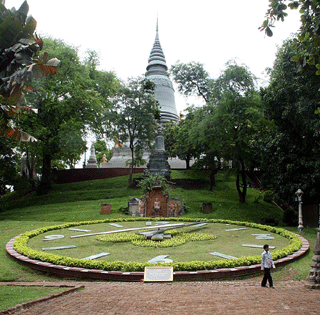 Phnom Penh is the vibrant bustling capital of Cambodia. Situated at the confluence of three rivers, the mighty Mekong, the Bassac and the great Tonle Sap, what was once considered the 'Gem' of Indochina. The capital city still maintains considerable charm with plenty to see. It exudes a sort of provincial charm and tranquillity with French colonial mansions and tree-lined boulevards amidst monumental Angkorian architecture. Phnom Penh is a veritable oasis compared to the modernity of other Asian capitals. A mixture of Asian exotica, the famous Cambodian hospitality awaits the visitors to the capital of the Kingdom of Cambodia.
Phnom Penh is the vibrant bustling capital of Cambodia. Situated at the confluence of three rivers, the mighty Mekong, the Bassac and the great Tonle Sap, what was once considered the 'Gem' of Indochina. The capital city still maintains considerable charm with plenty to see. It exudes a sort of provincial charm and tranquillity with French colonial mansions and tree-lined boulevards amidst monumental Angkorian architecture. Phnom Penh is a veritable oasis compared to the modernity of other Asian capitals. A mixture of Asian exotica, the famous Cambodian hospitality awaits the visitors to the capital of the Kingdom of Cambodia.
Here in the capital, are many interesting touristy sites. Beside the Royal Palace, the Silver Pagoda, the National Museum, the Toul Sleng Genocide Museum, the Choeng Ek Killing Fields and Wat Phnom, there are several market places selling carvings, paintings, silk, silver, gems and even antiques. Indeed, an ideal destination for a leisurely day tour. The whole area including the outskirts of Phnom Penh is about 376 square kilometres big. There are currently 2,009,264 people living in Phnom Penh.
The city takes its name from the re-known Wat Phnom Daun Penh (nowadays: Wat Phnom or Hill Temple), which was built in 1373 to house five statues of Buddha on a man made hill 27 meters high. These five statues were floating down the Mekong in a Koki tree and an old wealthy widow named Daun Penh (Grandma Penh) saved them and set them up on this very hill for worshiping. Phnom Penh was also previously known as Krong Chaktomuk (Chaturmukha) meaning "City of Four Faces". This name refers to the confluence where the Mekong, Bassac, and Tonle Sap rivers cross to form an "X" where the capital is situated.
Phnom Penh is also the gateway to an exotic land - the world heritage site, the largest religious complex in the world, the temples of Angkor in the west, the beaches of the southern coast and the ethnic minorities of the North-eastern provinces. There are also a wide variety of services including five star HOTELS AND budget guest houses, fine international dining, sidewalk noodle shops, neighbourhood pubs international discos and more.
Phnom Penh, like other Asian-City tourist destinations, is in the midst of rapid change. Over the past few years the number of restaurants and hotels have grown considerably and in the last year there had been a huge increase in the number of visitors. Come and see a real original as it won't be the same in a few years.
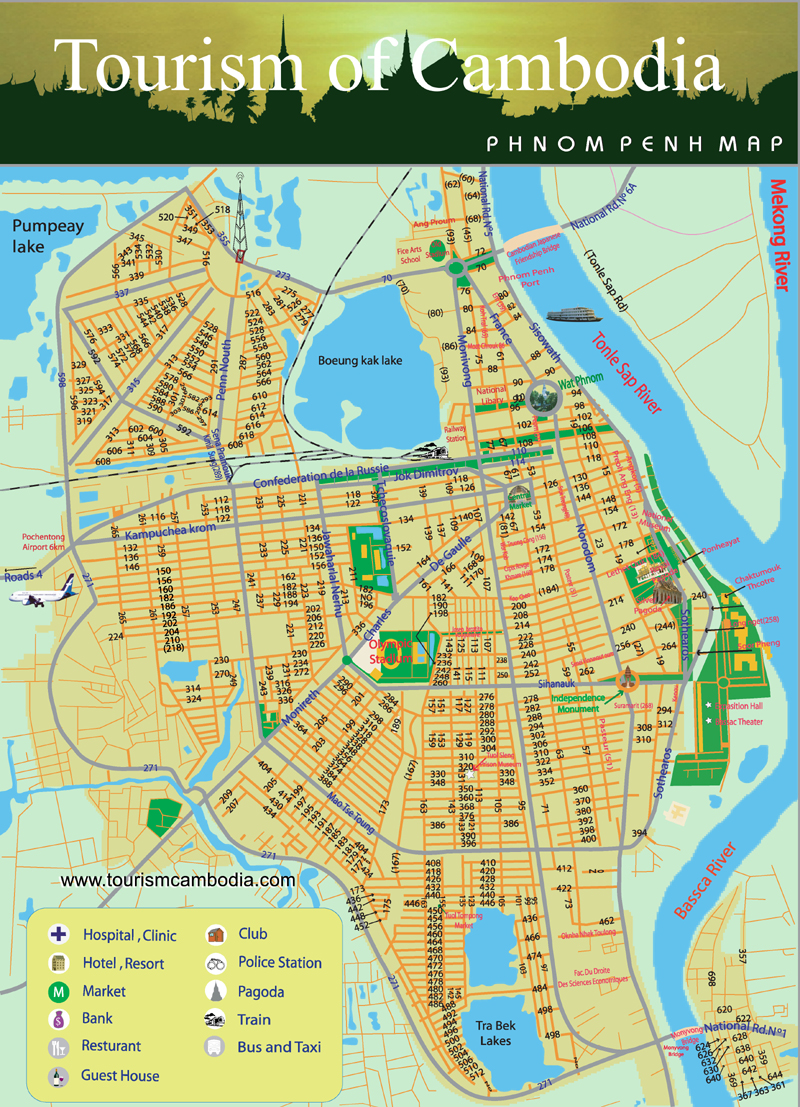 Phnom Penh is located in the southern heard of the country and fully surrounded by the Kandal Province. The municipality consists of the typical plain wet area for Cambodia, covering rice fields and other agricultural plantations. The province also features three of the biggest rivers of the country the Tonle Bassac, the Tonle Sap and the mighty Mekong.
Phnom Penh is located in the southern heard of the country and fully surrounded by the Kandal Province. The municipality consists of the typical plain wet area for Cambodia, covering rice fields and other agricultural plantations. The province also features three of the biggest rivers of the country the Tonle Bassac, the Tonle Sap and the mighty Mekong.
All three rivers cross to form an "X" at their confluence, where the capital is situated. These rivers provide potential freshwater and other resources. The city, located at 11.55 N 104.91667? E (11?33' North, 104?55' East) covers an area of 375 square kilometres (145 sq mi) which some 11,401 hectares (28,172 acres) in the municipality and 26,106 hectares (64,509 acres) of roads. The agricultural land in the municipality amounts to 34.685 square kilometres (13 sq mi) with some 1.476 square kilometres (365 acres) under irrigation.
The country has a tropical climate - warm and humid. In the monsoon season, abundant rain allows for the cultivation of a wide variety of crops. This year-round tropical climate makes Cambodia ideal for developing tourism. Travellers need not to fear natural disasters such as erupting volcanoes or earthquakes, and the country is not directly affected by tropical storms.
Climate: Cambodia can be visited throughout the year. However, those plans to travel extensively by road should be avoided the last two months of the rainy season when some countryside roads may be impassable. The average temperature is about 27 degrees Celsius; the minimum temperature is about 16 degrees. December and January are the coolest months, whereas the hottest is April.
General information about the provincial climate:
The city temperatures range from 15? to 38 ?C and experiences tropical monsoons. Monsoons blow from the Southwest inland, bringing moisture-laden winds from the Gulf of Thailand and Indian Ocean from May to October. The northeast monsoon ushers in the dry season, which lasts from November to March. The city experiences the heaviest precipitation from September to October with the driest period occurring from January to February.
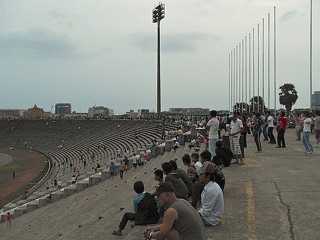 Phnom Penh is the vibrant bustling capital of Cambodia. Situated at the confluence of three rivers, the mighty Mekong, the Bassac and the great Tonle Sap, what was once considered the 'Gem' of Indochina. The capital city still maintains considerable charm with plenty to see. It exudes a sort of provincial charm and tranquillity with French colonial mansions and tree-lined boulevards amidst monumental Angkorian architecture. Phnom Penh is a veritable oasis compared to the modernity of other Asian capitals. A mixture of Asian exotica, the famous Cambodian hospitality awaits the visitors to the capital of the Kingdom of Cambodia.
Phnom Penh is the vibrant bustling capital of Cambodia. Situated at the confluence of three rivers, the mighty Mekong, the Bassac and the great Tonle Sap, what was once considered the 'Gem' of Indochina. The capital city still maintains considerable charm with plenty to see. It exudes a sort of provincial charm and tranquillity with French colonial mansions and tree-lined boulevards amidst monumental Angkorian architecture. Phnom Penh is a veritable oasis compared to the modernity of other Asian capitals. A mixture of Asian exotica, the famous Cambodian hospitality awaits the visitors to the capital of the Kingdom of Cambodia.
The current population in this municipality is about 2,009,264 people or 14 % of the country?s total population (14,363,519 person in Cambodia, 2007, provincial government data), with 621,948 male and 658,833 female. The population density is therefore 5,343.8 people per square kilometre. The population is Original Khmer 60%, Chinese 15%, Vietnamese 20% and 5% other. The population growth in the city is about 3.9%.
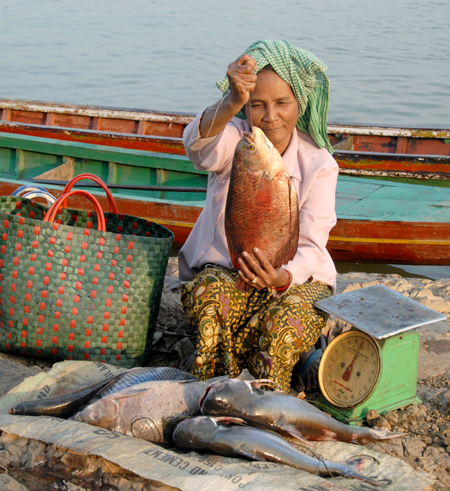 Double-digit economic growth rates in recent years have triggered an economic boom, with new hotels, restaurants, bars, and residential buildings springing up around the city. Phnom Penh's wealth of historical and cultural sites makes it also a very popular tourist destination. The main economy is based on commercial such as garments, trading, small and medium enterprises. The property business is booming since the past few years. Real estate is now getting very expensive. The two new sub-cities are under construction, where investors from Korea and Indonesia join with Cambodian investors. The investment project of Camko-city is estimated about more than 200 millions and will be finished in 2018. Because of its budget airlines flying from nearby countries directly to Phnom Penh, the leisure and business travellers are coming to enjoy themselves or to look for investment opportunities in Cambodia. So also the hotel business is likely more and more improving.
Double-digit economic growth rates in recent years have triggered an economic boom, with new hotels, restaurants, bars, and residential buildings springing up around the city. Phnom Penh's wealth of historical and cultural sites makes it also a very popular tourist destination. The main economy is based on commercial such as garments, trading, small and medium enterprises. The property business is booming since the past few years. Real estate is now getting very expensive. The two new sub-cities are under construction, where investors from Korea and Indonesia join with Cambodian investors. The investment project of Camko-city is estimated about more than 200 millions and will be finished in 2018. Because of its budget airlines flying from nearby countries directly to Phnom Penh, the leisure and business travellers are coming to enjoy themselves or to look for investment opportunities in Cambodia. So also the hotel business is likely more and more improving.
As Kandal province is around Phnom Penh it serves as an economic belt of the capital. For instance Cambodia has become the sixth largest garment exporter in the world in 2007 (most of these factories are in Kandal Province). The industry created job opportunities for about 0.5 million Cambodians and generated some 0.3 billion U.S. dollars of monthly payment for the employees. Also agricultural exports flourished in 2007, as palm oil, peanuts, rice, pepper and other rural products became ever more popular in the international markets.
Finally, luxury real estate project like the Longing Resort in Kandal province was demolished on July 31, as it expanded its land illegally and in effect constituted menace to the safety of the capital. The Asia Development Bank put Cambodia's economic growth rate for the past year at 9.5 percent and nine percent in 2008, while the Cambodian government gave a conservative estimation of seven percent both in 2007 and 2008.
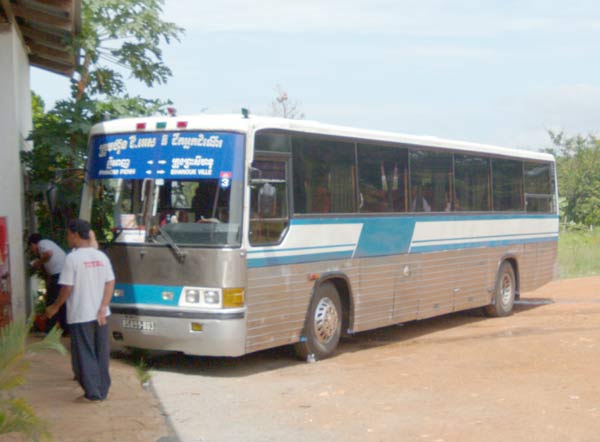 Phom Penh can be reached by either domestic flights, international flights or overland and speedboat from neighbouring provinces. Phnom Penh is a fairly easy city to get around. Though traffic is getting more congested these days, you can still travel the length of the city in less than 40 minutes. Regarding the economical boom these days, the traffic increases significantly.
Phom Penh can be reached by either domestic flights, international flights or overland and speedboat from neighbouring provinces. Phnom Penh is a fairly easy city to get around. Though traffic is getting more congested these days, you can still travel the length of the city in less than 40 minutes. Regarding the economical boom these days, the traffic increases significantly.
On arrival, taxis and motorcycle taxis (motodups) can be hired just outside the arrival lobby. There are no meter taxis (just developing this service). Taxis cost $7.00 for the 20-30 minute ride into the city centre. Cheaper, slower and less comfortable, motorcycle taxis can be hired for $2.00 into town. A usual taxi to the airport from town costs about $5-$7. Allow a minimum of 30-40 minutes to get to the airport, as you might get into some traffic jams during the rush hour.
The ferry port in Phnom Penh is on Sisowath Quay (the riverfront road) at Street 104, just north of the main riverfront park/restaurant area. If you are arriving in Phnom Penh, there are always motor taxis and car taxis waiting for fares. Motorcycle taxis run about R1500-R3000 and car taxis about $3-$5 to downtown hotels.
More common are un-metered, unmarked taxis, which can be arranged through your hotel or travel agent, and can also be found outside hotels along the Monivong Blvd. near Kampuchea Krom. A car plus driver costs you $20-$30/day. Shorter jaunts, for a minimum of $2-$3. 4WD vehicles will give you a ride for $60/day and up.
Short and long term rental of a wide variety of vehicles:
The omnipresent motos are the most common and fastest form of public transportation but are certainly not the safest. They are more prone to accidents and robberies than cars. Motos cost from 1000R-4000R for a trip in town and $6-$10 per day. Prices go surely up at night.
A few guesthouses, (e.g. Capitol Guesthouse) have bicycles for rent for around $1-1.5/day. Bicycle stores are clustered near the intersection of Streets 182 and 107. They do not rent bikes, but a used bike can be bought for about $30-40 and resold for around $20.
Motorcycles (100cc - 125cc) can be rented for $3 - $5/day. Tourists often rent 250cc dirt bikes, even if it's a bit too much power and weight for the slow city traffic (250cc for $10-13). For in-city driving, a 100cc is recommended. A 250cc is perfect for the poor roads outside Phnom Penh. Chaotic traffic makes cycling in the city challenging in the extreme. Roads outside the city vary dramatically in condition. If you do decide to ride, drive slowly, stay right, wear a helmet and remember that medical services are quite limited.
Ho Wah Genting offers bus service to nearby destinations using modern air-conditioned buses. Get off or on at any point along the line. Buses depart every 15 minutes to one hour, daily from 6am-6pm. 1200R-12000R. The station is at the corner of the Central Market. Route #1: Koki, Kien Svay, Neak Luong, And Route #2: Takhmao, Takeo, And Route #4: Kampong Speu, Sihanoukville, And Route #5: Oudong, Kampong Chhnang, Route #6: Raw Kakong, Kampong Cham. Also near the central market (Southwest corner) you may find the biggest bus station in town. Sorya Bus Company takes you almost everywhere in the country where a paved road is available. The buses are a little bit older than from some other companies, but still featuring air-con and usual seats. The prices are reasonable (approx. $1 for 70-80km).
The humble cyclo can be a romantic and practical form of transport though not as safe as a car or fast as a motor. Cyclos are easier than motors and during a rain they offer a drier ride. They often charge twice as much as a motos and are notorious for overcharging tourists, but keep in mind that?s physical work.
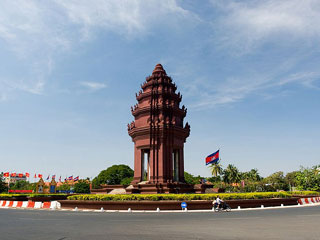 An Angkorian style tower, the inimitable place in the whole city, located in the heart of the capital. It was built in 1958 to Sybilles Cambodian Independence Day after winning back their independence from the French protectorate on the 9th of November 1953. The monument attracts many tourists for its peculiar looking but unique style distinguishes it from all the buildings in the city. It is also used as a memorial place dedicated to the Cambodian's patriot who died for the country.
An Angkorian style tower, the inimitable place in the whole city, located in the heart of the capital. It was built in 1958 to Sybilles Cambodian Independence Day after winning back their independence from the French protectorate on the 9th of November 1953. The monument attracts many tourists for its peculiar looking but unique style distinguishes it from all the buildings in the city. It is also used as a memorial place dedicated to the Cambodian's patriot who died for the country.
The Independence Monument (Vimean Ekareach) was inaugurated on November 9, 1962 to celebrate the independence from the French in 1953, but now also serving as a cenotaph to Cambodia?s war dead. The 20-meter high monument was designed by Cambodian architect, Vann Molyvann, and is shaped in the form of a lotus, which also can be seen at Angkor and other Khmer historical sites. You are not allowed to enter the monument. At night it is lit with blue, red and white light (the colours of the national flag) and it should be an impressive sight - but I didn?t see it.
There is a big open park at the Independence Monument and it seems to be a popular place among the locals. Smacked right at the corner of Norodom and Sihanouk Blvd, this piece of landmark is hard to miss. I took a nice picture of this piece but be careful because it is located in the middle of a roundabout.The monument was built in 1962 to celebrate Cambodia's independence from the foreign rule. It also serves as a monument to Cambodias war dead. It is the site for celebrations and services.When walking around in the city of Phnom Penh, have a look on the Independence Monument,10 minutes walking behind the Royal Palace.
It is surrounded by very large parcs and fountains and the monument itself is not the most impressive in the city. The Independence Monument in Phnom Penh, capital of Cambodia, was built in 1958 following the country's independence from France. It stands on the intersection of Norodom and Sihanouk Boulevards in the centre of the city. It is in the form of a lotus-shaped stupa, of the style seen at the great Khmer temple at Angkor Wat and other Khmer historical sites.The Independence Monument was inaugurated in 1958 to celebrate Cambodia's independence from foreign rule, now it also serves as a monument to Cambodia's war dead. At night the monument is illuminated by red, blue and white floodlights, the colors of the Cambodian flag. It is the site of celebrations and services on holidays such as Independence Day and Constitution Day.
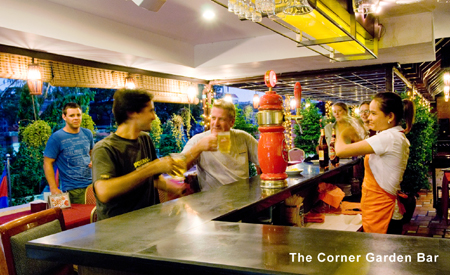 Cambodia ranks among the world's poorest countries, so it comes as a pleasure surprise to find that Phnom Penh has a vast range of restaurants to suit all pockets and tastes, from noodle shops and market stalls to sophisticated, pricey Western places; even guesthouses often have small restaurants offering Western style fare, including American breakfasts, and Khmer and Chinese dishes. Many of the restaurants catering to tourists and visitors line the riverfront dining and shopping area near the Royal Palace. Street 278 (near Independence Monument) and Boeng Keng Kang 1 is dotted with local and foreign restaurants. Budget restaurants and relaxing bars can be found along Street 93 next to the Boeung Kak Lake, an area popular with backpackers.
Cambodia ranks among the world's poorest countries, so it comes as a pleasure surprise to find that Phnom Penh has a vast range of restaurants to suit all pockets and tastes, from noodle shops and market stalls to sophisticated, pricey Western places; even guesthouses often have small restaurants offering Western style fare, including American breakfasts, and Khmer and Chinese dishes. Many of the restaurants catering to tourists and visitors line the riverfront dining and shopping area near the Royal Palace. Street 278 (near Independence Monument) and Boeng Keng Kang 1 is dotted with local and foreign restaurants. Budget restaurants and relaxing bars can be found along Street 93 next to the Boeung Kak Lake, an area popular with backpackers.
Is mainly catering the local Khmer Food, the Fresh Fruit Shake and Juices specialties for this hot month from Oct to May. It is located at the first floor of Mittapheap Hotel, corner street 174 next to Wat Koh high school and Pagoda.
This famous international bar and restaurant is still as much a journalist?s meeting. It is located on the second floor of a beautiful old Colonial era building with open balcony providing a spectacular, sweeping view of the Tonle Sap and Mekong Rivers. The FCC kitchen offers a good selection of nicely prepared contemporary, modern, and mainstream western dishes as well as some of the best wood-fired oven pizza in town. Also displaying photo shows and exhibitions. Fresco Delicatessen on the ground floor. Upper price limit. St. 363 on the riverside.
This international restaurant is the Street 278 area annex of the very popular Garden Center Caf, offering the same excellent western meals like steaks, baked ham, baked salmon, burgers, sloppy joes, Asian dishes and a great selection of salads and vegetarian dishes. All home cooking and generous portions. Relaxed, clean, green and family atmosphere. Conveniently located on Street 57 just around the corner from the Boeng Keng Kang 1 Street 278 hotel area.
This international caf and restaurant is genially set in a nice gallery ambiance. They offer a brilliant selection of coffees, teas and muffins. Nice selections of salads, sandwiches made to order on homemade bread, fajitas, lots of veggie dishes and all-day breakfasts including omelettes, pancakes, French toast, muesli and more. Indoor gallery seating and airy balcony seating overlooking the green park and the Independence Monument. Changing art and photo exhibitions. WiFi Hotspot. St. 56, Sihanouk Blvd. (Near to the Independence Monument).
This is an authentic classical Thai and Khmer food restaurant with dishes at reasonable prices. Shop house sized restaurant with pleasant indoor seating. Fairly large selection of dishes. Very good preparation. Good selection of vegetarian offerings. Good reviews from patrons. Located on Street 130 just off the riverfront.
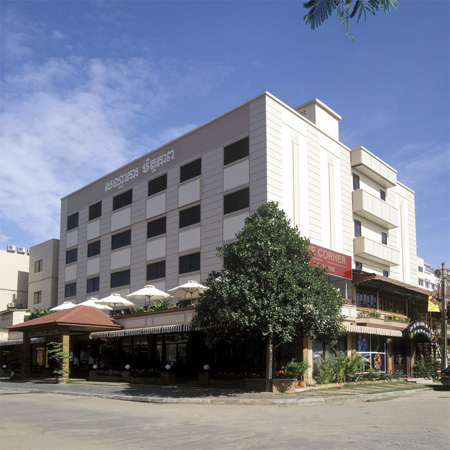 There is no shortage of accommodation in Phnom Penh, with an increasing number of guesthouses and hotels across the city catering for all pockets and tastes, from basic rooms with fans to opulent colonial suites with every luxury. No matter when you arrive, you should have no difficulty finding a room, although it's no surprise that the very cheapest room fill up quickly. Arriving in the morning stands you have a better chance of getting really inexpensive accommodation, as many people check out early to catch onward transport. If you intent to stay for more than a couple of nights it's worth asking about getting a discount at guesthouses and mid-range places. For HOTEL RESERVATION, visit: http://www.tourismcambodia.com/hotels/:
There is no shortage of accommodation in Phnom Penh, with an increasing number of guesthouses and hotels across the city catering for all pockets and tastes, from basic rooms with fans to opulent colonial suites with every luxury. No matter when you arrive, you should have no difficulty finding a room, although it's no surprise that the very cheapest room fill up quickly. Arriving in the morning stands you have a better chance of getting really inexpensive accommodation, as many people check out early to catch onward transport. If you intent to stay for more than a couple of nights it's worth asking about getting a discount at guesthouses and mid-range places. For HOTEL RESERVATION, visit: http://www.tourismcambodia.com/hotels/:
If you're on a short pocket travelling and looking for a CHEAP ACCOMMODATION the Lake Side next to the only lake of Phnom Penh will be the place to pop in. There is plenty of very basic budget and mid-range guesthouses from US$1.5-10 per room and night. The sunsets from one of the wooden platforms over the Boeng Kak Lake are pretty famous in town.
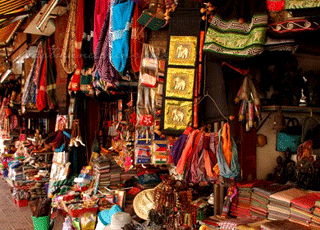 Around the main buildings are stalls offering Krama's (red and white checked scarves), stationery, household items, clothes for sarongs, flowers and second hand clothes, usually from Europe and the US. For photographers, the fresh food section affords a lot of opportunities. There are a host of good value food stalls on the structure's western side, which faces Monivong Blvd. Central Market is undoubtedly one of the best of Phnom Penh's markets for browsing. It is the cleanest and has the widest range of products for sale. Opening hours are from early morning until early evening.
Around the main buildings are stalls offering Krama's (red and white checked scarves), stationery, household items, clothes for sarongs, flowers and second hand clothes, usually from Europe and the US. For photographers, the fresh food section affords a lot of opportunities. There are a host of good value food stalls on the structure's western side, which faces Monivong Blvd. Central Market is undoubtedly one of the best of Phnom Penh's markets for browsing. It is the cleanest and has the widest range of products for sale. Opening hours are from early morning until early evening.
More commonly referred to by foreigners as the Russian Market, this is located at the corner of St. 440 and st.163, south of Mao Tse Tung Blvd. It is the best place in town for souvenir shopping, having a large range of real and fake antiquities. Items for sale include miniature Buddha's, silk, silver jewelry, gems, video, ganja and a host of other goodies. Clothes such as t-shirts, trousers, jackets or shoes are very reasonable. It's well worth popping in for a browse.
Don't be confused with the Russian Market, it's not that one even if it sounds like. The market is located in a huge yellow-bleached house looking like a shopping mall from outside next to Capitol Tours, east from the Olympic Stadium and closed to the Monivong Blvd. It features almost all kind of products focusing on luxury foodstuffs, costume jewellery, imported toiletries, second-hand and new clothes, and some electrical devises. Once you enter it you'll find a kind of labyrinth with hundreds of small overloaded stalls. It's worth popping in if you want to experience an older Khmer-style market.

